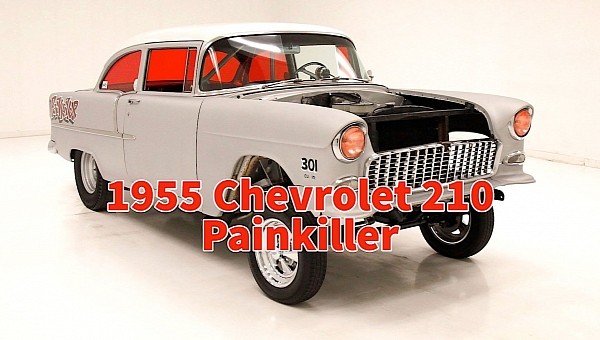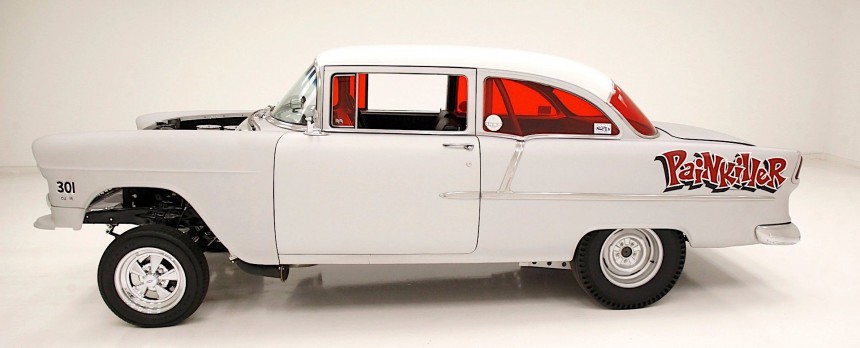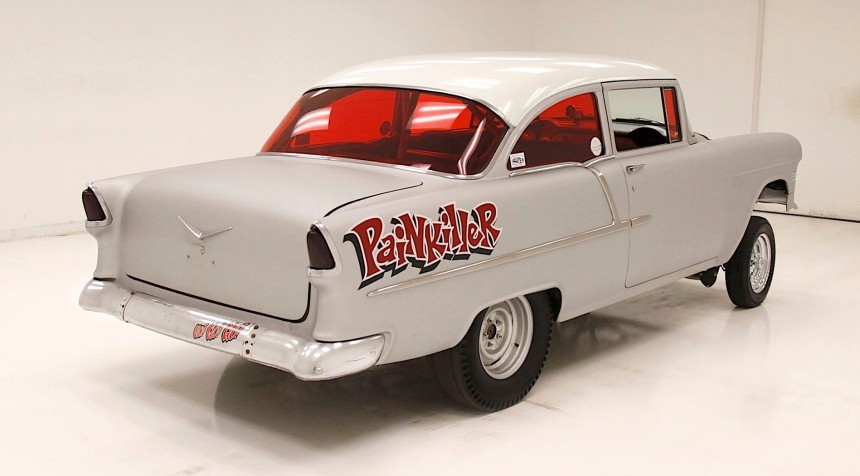A lot of decades have passed since the mid-1950s, and with them came and went a lot of different ways of designing cars. As an addendum to that, each human generation since that era has had its share of beautiful cars. Yet when looking back at them all, I find few still are as attractive as Chevrolet’s Tri-Five series.
Comprising the 150, 210, and Bel Air of 1955, 1956, and 1957, this series meant so much for the car-loving American that they survive even to this day. And by “survive” I mean the examples that have been saved and given a second life as incredible customs.
There are plenty of them to go around, and most of them have one major thing in common: they’ve been remade in the spirit and style of the original. That means they’ve kept their beautiful design lines, they can still be driven down the road, most of the time thanks to some seriously upgraded powertrain and underpinnings, or they can be taken to specialized shows to dazzle the crowds.
But there are exceptions to that rule, Tri-Fives that go for a more extreme approach. In doing so, builders kind of ruin the original appeal and style of the base cars. Yet they often make up for that through the shocking finished product they end up showing to the world.
You see, custom Tri-Fives don’t only come as shiny restoration projects, or as modernized show cars. They also come as gassers, that breed of hot rods that harkens back to a type of drag race car extremely popular in the 1950s to the 1970s. They’re no longer Chevys we can look at with admiration, but impressive machines nonetheless.
Like this one here. Originally a 1955 Chevy 210, meaning an example from halfway through the life of the model, it once looked like all other 210s, with all its body elements in the right place, an even and proud stance on the road, and all those elegant side chrome decorations 210s usually came with. A far cry, that is, from its current state.
As usual when it comes to race-bound gasser rides, a lot of things, both on the outside and on the inside, had to be sacrificed on the altar of weight saving. Take a quick look at this nose-up machine and you’re instantly hit by the lack of a hood and front bumper, but also by the presence of a front grille, stylish but somehow out of place on that trimmed-down front end.
What’s left of the body is wrapped in satin silver (except for the roof, which comes in white), made to shine by the chrome elements that somehow managed to survive the cuts, on the window surrounds, mirrors, and around the front lights. The rear panels, which are still the original ones, are where the ride’s name is written in big, red letters: Painkiller. Last but not least, the exterior look is completed by 15-inch Cragar wheels up front and mismatched steel ones in raw metal.
The cabin is surrounded by windows in a bright red tint (except for the windscreen, of course), and comes as a visually disappointing, but racing-fit interior. Up front, you get a pair of low-back bucket seats in black vinyl, but no carpeting or headliner.
In front of the seats is a rather elegant-looking dashboard that, with the exception of the naked steel that makes up its skin, is as it came from the factory. Even the dual fan design is still there, with the one in front of the driver holding the car’s gauges, and the one on the right spelling out the Chevrolet name. Aside from the main gauges, the car got a series of other such tools, needed to properly keep an eye on what the engine is doing: a high-mounted tachometer on the dash, and two other dials below and behind the steering wheel.
If you look at the rear of the 210, you’ll not see a bench there, but only a black vinyl panel and the steel tube rollbar separating it from the front seats.
Exposed to the elements in the engine bay is a smaller engine than we would have expected. Initially a 283ci small block, the unit was bored to 301ci, and rocks dual Carter 4-barrel carburetors and double hump 462 cylinder heads. We don’t know how much power it develops, but it is all harnessed by a 4-speed manual transmission and sent to a Ford 9-inch rear.
The 1955 Chevrolet 210 Painkiller shows almost 32,000 miles (51,500 km) of use, but we’re not told if that’s the original mileage of the base car, or just the miles traveled after its conversion to a gasser in the hands of an undisclosed custom garage.
The Pennsylvania-based dealer selling this thing, Classic Auto Mall, is asking $29,000 for it, which if you think about it is not that bad for a car meant to be trashed on the drag strip.
There are plenty of them to go around, and most of them have one major thing in common: they’ve been remade in the spirit and style of the original. That means they’ve kept their beautiful design lines, they can still be driven down the road, most of the time thanks to some seriously upgraded powertrain and underpinnings, or they can be taken to specialized shows to dazzle the crowds.
But there are exceptions to that rule, Tri-Fives that go for a more extreme approach. In doing so, builders kind of ruin the original appeal and style of the base cars. Yet they often make up for that through the shocking finished product they end up showing to the world.
You see, custom Tri-Fives don’t only come as shiny restoration projects, or as modernized show cars. They also come as gassers, that breed of hot rods that harkens back to a type of drag race car extremely popular in the 1950s to the 1970s. They’re no longer Chevys we can look at with admiration, but impressive machines nonetheless.
As usual when it comes to race-bound gasser rides, a lot of things, both on the outside and on the inside, had to be sacrificed on the altar of weight saving. Take a quick look at this nose-up machine and you’re instantly hit by the lack of a hood and front bumper, but also by the presence of a front grille, stylish but somehow out of place on that trimmed-down front end.
What’s left of the body is wrapped in satin silver (except for the roof, which comes in white), made to shine by the chrome elements that somehow managed to survive the cuts, on the window surrounds, mirrors, and around the front lights. The rear panels, which are still the original ones, are where the ride’s name is written in big, red letters: Painkiller. Last but not least, the exterior look is completed by 15-inch Cragar wheels up front and mismatched steel ones in raw metal.
The cabin is surrounded by windows in a bright red tint (except for the windscreen, of course), and comes as a visually disappointing, but racing-fit interior. Up front, you get a pair of low-back bucket seats in black vinyl, but no carpeting or headliner.
If you look at the rear of the 210, you’ll not see a bench there, but only a black vinyl panel and the steel tube rollbar separating it from the front seats.
Exposed to the elements in the engine bay is a smaller engine than we would have expected. Initially a 283ci small block, the unit was bored to 301ci, and rocks dual Carter 4-barrel carburetors and double hump 462 cylinder heads. We don’t know how much power it develops, but it is all harnessed by a 4-speed manual transmission and sent to a Ford 9-inch rear.
The 1955 Chevrolet 210 Painkiller shows almost 32,000 miles (51,500 km) of use, but we’re not told if that’s the original mileage of the base car, or just the miles traveled after its conversion to a gasser in the hands of an undisclosed custom garage.
The Pennsylvania-based dealer selling this thing, Classic Auto Mall, is asking $29,000 for it, which if you think about it is not that bad for a car meant to be trashed on the drag strip.


















